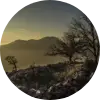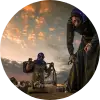
















Devegeçidi Bridge, located on the Devegeçidi stream of the Tigris River on the road to Eğil, north of Diyarbakır, is known locally as the "Cümek Village Bridge". This bridge, known as "Karaköprü" in old maps, is sometimes confused with another bridge on the Diyarbakır-Ergani road.
The historical and architectural significance of the Devegeçidi Bridge comes from the inscriptions on it. The first inscription indicates that it was built in 615 (1218) by Mahmud b. Muhammad b. Karaarslan from the Artuqids, and the architect was Ca‘fer b. Mahmud al-Halabi. The second inscription, placed inside the pointed arch known as the Turkish arch, also mentions Mahmud b. Muhammad and the architect Ca‘fer b. Mahmud from the same family. The third inscription contains the 261st verse of the Bakara Surah, praising those who spend their wealth in the way of Allah.
The Devegeçidi Bridge has a regular black stone covering and is 95 steps long and 5 steps wide. After four large arches, there are three small eyes that narrow towards the end. The eyes have pointed arches, and the bridge's platform descends to the level of the key stone. However, it is believed that the platform should originally have been higher, indicating that the upper part of the bridge may have been altered in later repairs.
The Devegeçidi Bridge is an important monument reflecting the historical and architectural heritage of the Artuqid Principality. The repair and restoration of the bridge are crucial for the preservation of its historical and cultural values.